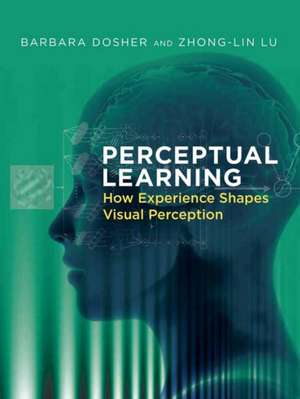Perceptual Learning
Autor Barbara Dosheren Limba Engleză Hardback – 13 oct 2020
This book is written for anyone who wants to understand the phenomena and theories of perceptual learning or to apply the technology of perceptual learning to the development of training methods and products. Our aim is to provide an introduction to those researchers and students just entering this exciting field, to provide a comprehensive and integrated treatment of the phenomena and the theories of perceptual learning for active perceptual learning researchers, and to describe and develop the basic techniques and principles for readers who want to successfully incorporate perceptual learning into applied developments. The book considers the special challenges of perceptual learning that balance the competing goals of system stability and system adaptability. It provides a systematic treatment of the major phenomena and models in perceptual learning, the determinants of successful learning and of specificity and transfer. The book provides a cohesive consideration of the broad range of perceptual learning through the theoretical framework of incremental learning of reweighting evidence that supports successful task performance. It provides a detailed analysis of the mechanisms by which perceptual learning improves perceptual limitations, the relationship of perceptual learning and the critical period of development, and the semi-supervised modes of learning that dominate perceptual learning. It considers limitations and constraints on learning multiple tasks and stimuli simultaneously, the implications of training at high or low levels of performance accuracy, and the importance of feedback to perceptual learning. The basis of perceptual learning in physiology is discussed along with the relationship of visual perceptual learning to learning in other sensory domains. The book considers the applications of perceptual learning in the development of expertise, in education and gaming, in training during development and aging, and applications to remediation of mental health and vision disorders. Finally, it applies the phenomena and models of perceptual learning to considerations of optimizing training.
Preț: 373.49 lei
Preț vechi: 434.29 lei
-14% Nou
Puncte Express: 560
Preț estimativ în valută:
71.47€ • 75.15$ • 59.05£
71.47€ • 75.15$ • 59.05£
Carte disponibilă
Livrare economică 26 martie-09 aprilie
Livrare express 12-18 martie pentru 51.30 lei
Preluare comenzi: 021 569.72.76
Specificații
ISBN-13: 9780262044561
ISBN-10: 0262044560
Pagini: 472
Dimensiuni: 183 x 235 x 30 mm
Greutate: 0.97 kg
Editura: MIT Press Ltd
ISBN-10: 0262044560
Pagini: 472
Dimensiuni: 183 x 235 x 30 mm
Greutate: 0.97 kg
Editura: MIT Press Ltd
Notă biografică
Barbara Dosher is Distinguished Professor of Cognitive Sciences at the University of California, Irvine. She is coauthor of Visual Psychophysics: From Laboratory to Theory (MIT Press).
Zhong-Lin Lu is Chief Scientist, Associate Provost for Sciences, Director of the NYU-ECNU Institute of Brain and Cognitive Science, Professor of Neural Science and Psychology at NYU Shanghai, as well as Professor of Neural Science and Psychology and Global Network Professor at NYU. He is coauthor of Visual Psychophysics: From Laboratory to Theory (MIT Press).
Zhong-Lin Lu is Chief Scientist, Associate Provost for Sciences, Director of the NYU-ECNU Institute of Brain and Cognitive Science, Professor of Neural Science and Psychology at NYU Shanghai, as well as Professor of Neural Science and Psychology and Global Network Professor at NYU. He is coauthor of Visual Psychophysics: From Laboratory to Theory (MIT Press).
Cuprins
Chapter 1: Principles of perceptual learning
Chapter 2: Perceptual learning in visual tasks
Chapter 3: Specificity and transfer
Chapter 4: Mechanisms of perceptual learning
Chapter 5: Physiological basis
Chapter 6: Models
Chapter 7: Feedback
Chapter 8: Modeling transfer and specificity
Chapter 9: Top-down influences of task, attention, and reward
Chapter 10: Forms of plasticity and other modalities
Chapter 11: Applications
Chapter 12: Optimization
Chapter 2: Perceptual learning in visual tasks
Chapter 3: Specificity and transfer
Chapter 4: Mechanisms of perceptual learning
Chapter 5: Physiological basis
Chapter 6: Models
Chapter 7: Feedback
Chapter 8: Modeling transfer and specificity
Chapter 9: Top-down influences of task, attention, and reward
Chapter 10: Forms of plasticity and other modalities
Chapter 11: Applications
Chapter 12: Optimization
Descriere
"Acomprehensiveanalysisofperceptuallearning,especiallyinthevisualdomain,futuredirectionsandpotentialapplications"--
